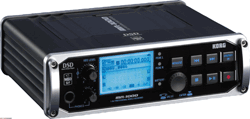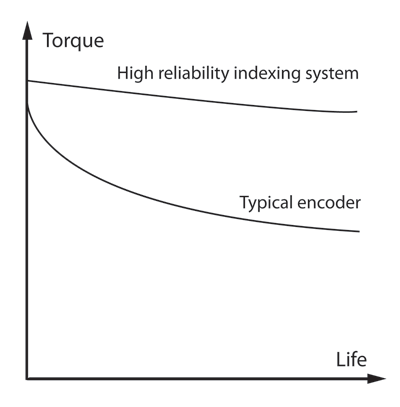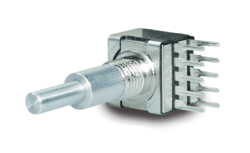Making the switch to high-end rotary encoders for RF systems
Because encoders limit the number of controls required to increase functionality, they reduce the real estate needed in a given piece of equipment and, in turn, can reduce the point of focus or operating complexity for the equipment user to a single control
BY JUSTIN MOLL
Elma Electronic, Fremont, CA
http://www.elma.com
Since the dawn of electronic equipment design, electronic engineers were always being pressed to allow for evolving functional demands. This brought about the concept of concentric potentiometers and rotary switches. These original inner/outer shaft controls were developed to provide dual functionality in limited spaces a simple idea based on intuitive operation. However, concentric control concepts were always expensive to realize and were left to be employed in audio systems and/or other high-end devices.
Smart ergonomic savings
The recording console or mixing desk has long-suffered from an overcrowding of components, resulting in user frustration. By providing two switches in one dual-concentric encoders save valuable real-estate on multimedia systems that are getting smaller and smaller. This allows the system to not only have a smaller profile, but retain an ergonomic and intuitive design (see Fig. 1) .

Fig. 1. Setting the right and left channels with a rotary switch element provides intuitive operation of audio equipment.
Aside from enhancing the system design, the encoder needs to meet other performance criteria for the demanding audio professional or portable radio user. One feature that experienced users demand is “tactile feedback.” The switching click that you can feel and hear when the dial is turned is what we call “click with a kick.” This sound and feeling is highly important to the user’s perception of quality.
Professional sound mixers work by sensory perception, immersing themselves in their music, relying on their acute sense of hearing to get the right mix of sounds. They apply the same sensitivity when operating the controls on the mixing desk. If a switch feels mushy or does not sit precisely in a given setting, there could also be some sonic implications as well. Clear, defined, crisp switching clicks with a solid feel conveys a message of both sonic and mechanical quality. Also, many mixing rooms are dimly lit. The user may need to look somewhere other than the mixing board while turning the encoder. The “click with a kick” feature allows the user to realize exactly how many channels or positions he has turned the dial, without looking at it. These same issues also apply to portable radio users, such as emergency response professionals.
The tactile feedback not only aides the user, but lets him know the encoder is of a high design quality. When an encoder wears, most will have the detents (positions of the switch) wear unevenly and the contacts will also deteriorate quickly. (What may be surprising is that usually the detents will wear before the contacts.) However, encoders can be designed with a spring mechanism that vastly decreases wear and maintains its feel throughout the encoder life. When the encoder does wear, it is even distributed across all indents. Therefore, the performance is almost imperceptible across the encoder lifecycle.
Rotational life
When speaking of rotational life, it is important to clarify the meaning. In this case, we are talking about the encoder doing a complete 360 turn. Each turn of the switch will slowly degrade the contacts over time. In many low cost switches, the particles from the indexing mechanism can gradually sheer off into the contact chamber itself. The particles (usually of steel, brass or plastic), can create opens or shorts in multiple positions throughout the normal rotation of the switch. There is also the problem of inexpensive designs that can cause premature wearing of contacts (from a mechanical standpoint, not electrically), which causes the switch to become intermittent (see Fig. 2 ). Typically, rotary switches and coded switches will fail mechanically before they fail electrically. The contact mechanisms on really cheap switches and encoders are notorious for premature failure even under the best of conditions.

Fig. 2. This chart illustrates the performance degradation of typical switches versus a high-reliability switch.
For high reliability, the delicate contact surfaces of encoders must be extremely precise and have an ample coating of gold; and the spring tensions must be well balanced (see Fig. 3 ) for close-up of gold contacts with a thick, rugged construction. The result is a switch or encoder that works well within specifications throughout a long rotational life.

Fig. 3. These switches are plated with gold 3 μm thick to survive the wear of a high-rotational life and prevent corrosion.
Increasing functions
Mixers have an exceptional set of demand criteria space saving, functionality, tactile feedback, and cost savings. These goals can be achieved by the two time-tested concepts: the encoder for electrical functionality and the concentric design for density and ergonomic considerations. A dual-concentric encoder combines two complete rotary encoders into a single unit. For both encoder sections, there are often between 16 and 32 positions; alternatively, the encoders may be available without detents. In the Elma Type 37 example (see Fig. 4 ), each revolution generates 8 or 16 impulses per rotation, per channel. Switching torque can be selected according to the application, and an integrated pushbutton function via the inner shaft can also be selected. Encoders typically offer various standard shaft lengths and shapes.

Fig. 4. In essence, this dual-concentric encoder provides two switches in one.
Dual-concentric encoders should be designed to allow users to configure the two rotary encoder sections independently of one another, with variable switching torques. This means that indexing feel for each section can be specifically tailored to the application. This allows flexibility to be used in various applications, potentially increasing economies of scale and keep customization costs to a minimum.
The concept of compact size, full functionality and reliability can also be applied to a variety of other products like portable radio equipment. In this area, compact radio units are frequently attached to a belt and users with an ear-fitted headset speak into a mouth-level microphone. These devices are then operated by means of a small number of buttons on the front or top face. In such cases, the advantages of concentric rotary switches are considerable. The radio operator can, for example, select the communication group from the outer ring and adjust the volume using the inner knob, with additional functionality being selected via the inner-shaft pushbutton.
Versatility
Encoders can also be designed with a great deal of flexibility. It is possible to modify shaft lengths and shapes to meet a customer’s specification for proper knob interfacing. Conversely, a hollow, outer-shaft-only version of a dual-concentric encoder (no inner shaft) provides free space for other control elements or components. This enables equipment designers to produce new variants to their control panel designs by simply fitting another switch, potentiometer or other component in the hollow shaft, thereby enhancing the functionality of the original design. Illumination or indicating functions can be easy to integrate: an LED or light tube can be built into the hollow shaft to make the switching unit easy to read in poor light or show the state of operation.
Dual-concentric encoders fill a need in the market for alternative approaches to control concepts. The concentric design lends itself to all kinds of innovative applications. With its high versatility and compact size, these encoders are truly creating new avenues of man-machine interface concepts. These encoders are helping to transform the design and user experience for audio and multimedia systems. ■
Advertisement
Learn more about Elma Electronic





